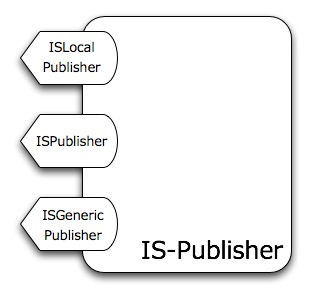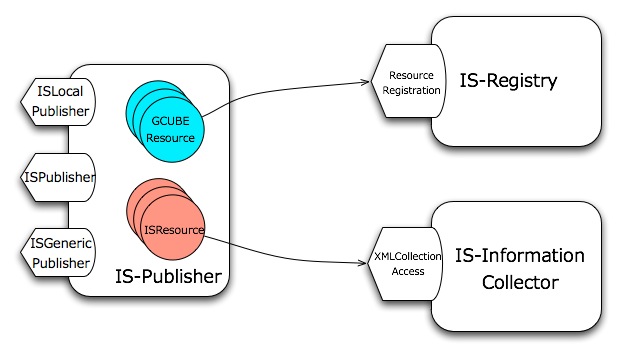Difference between revisions of "IS-Publisher"
Manuele.simi (Talk | contribs) (→Library Implementation) |
Manuele.simi (Talk | contribs) (→Design) |
||
| Line 20: | Line 20: | ||
=== Managed Resources === | === Managed Resources === | ||
| − | |||
==== Instance State ==== | ==== Instance State ==== | ||
Revision as of 01:27, 1 April 2011
In conjunction with the IS-Client and the IS-Notification, the IS-Publisher represents the mediation layer gCube Services will rely on to interact with the Information Service as a whole.
Contents
Design
The IS-Publisher is a Java library providing a reference implementation for a group of interfaces defined in the gCore Framework. The purpose of these interfaces is to define the behavior of providers of information to the the Information System.
More specifically:
- by implementing the
org.gcube.common.core.informationsystem.publisher.ISPublisherinterface, the library allows gCube services to publish GCUBEResources and instances' states as of WS-ResourceProperty documents; - by implementing the
org.gcube.common.core.informationsystem.publisher.ISGenericPublisherandorg.gcube.common.core.informationsystem.publisher.ISResourceinterfaces, the library provides a way to publish generic XML documents in the IS; - by implementing the
org.gcube.common.core.informationsystem.publisher.ISLocalPublisherinterface, it provides a subscription/notification mechanism based on local events.
At runtime, all the above interfaces are dynamically bound by gCore to the implementation provided by the library.
Each registration request creates an internal resource sent to the appropriate IS service. Instance states and generic XML documents are wrapped as ISResources and sent to the Information Collector. GCUBEResources are instead sent to the ISRegistry service for validation and approval.
Managed Resources
Instance State
An instance state is the set stateful WS-Resource created by that instance following the WSRF patterns.
In order to be published, a WS-Resource has to expose a view of its state as a mean of ResourceProperty and declare a registration file for that properties in its JNDI (<service folder>/etc/deploy-jndi-config.xml). This declaration is obtained through the publicationProfile element inside the service section.
This is an example of such declaration:
<service name="..."> <resource name="publicationProfile" type="org.gcube.common.core.state.GCUBEPublicationProfile"> <resourceParams> <parameter> <name>factory</name> <value>org.globus.wsrf.jndi.BeanFactory</value> </parameter> <parameter> <name>mode</name> <value>push</value> </parameter> <parameter> <name>fileName</name> <value>Registration.xml</value> </parameter> </resourceParams> </resource> </service>
The registration file specifies which properties have to be published, when and how following the syntax defined for the WS-MDS Aggregator Source registrations. The following example shows a registration file for 3 resource properties (RPString, RPDate, RPAny):
<ServiceGroupRegistrationParameters xmlns:sgc="http://mds.globus.org/servicegroup/client" xmlns:xsd="http://www.w3.org/2001/XMLSchema" xmlns:xsi="http://www.w3.org/2001/XMLSchema-instance" xmlns:agg="http://mds.globus.org/aggregator/types" xmlns="http://mds.globus.org/servicegroup/client"> <Content xsi:type="agg:AggregatorContent" xmlns:agg="http://mds.globus.org/aggregator/types"> <agg:AggregatorConfig> <agg:GetMultipleResourcePropertiesPollType xmlns:stateful="http://gcube-system.org/namespaces/test/stateful"> <agg:PollIntervalMillis>60000</agg:PollIntervalMillis> <agg:ResourcePropertyNames>stateful:RPString</agg:ResourcePropertyNames> <agg:ResourcePropertyNames>stateful:RPDate</agg:ResourcePropertyNames> <agg:ResourcePropertyNames>stateful:RPAny</agg:ResourcePropertyNames> </agg:GetMultipleResourcePropertiesPollType> </agg:AggregatorConfig> <agg:AggregatorData/> </Content> </ServiceGroupRegistrationParameters>
Note that the ResourcePropertyNames have to be fully qualified with the namespace declared in the service's WSDL (http//gcube-system.org/namespaces/test/stateful in the example above).
Name of the file aside, the other parameter to consider in the JNDI file is the mode. Clients may select the push or pull to publish their instance state. The chosen mode heavily impacts on the behavior of the ISPublisher.
Publishing with push mode
With the push mode, the resource properties are (re)published whenever the values of one of them changes. If the RPs change every now and then, intermittently or there are peaks of changes in the RPs but longer periods without any change, this is the preferred way to go.
Publishing with pull mode
When RPs change quite frequently and constantly and it's not critical to have them refreshed immediately, the pull mode has to be selected. In this modality, the ISPublisher periodically harvests and collects the RP values from the WS-Resource and publishes them in the Information Collector service.
The polling period is indicated in the PollIntervalMillis parameter inside the registration file.
GCUBEResource
GCUBEResource profiles are managed by interacting with the ResourceRegistration portType of IS-Registry service. The ISPublisher here acts as a simple mediator by selecting the IS-Registry instance in the publishing scope and invoking its operations.
XML Resource
Starting from the release 3.0 (Feb 2011), the ISPublisher offers the possibility to publish well-formed XML documents in the IS. This feature exploits the new XMLCollectionAccess portType of the Information Collector compliant with the WS-DAIX specification.
Library Implementation
Bulked Publications
Sample Usage
Dealing with GCUBEResources
How to publish a GCUBEResource
The registerGCUBEResource operation has to be invoked to publish a profile in the IS. The operation takes the following parameters as input:
- the resource to publish, an instance of a sub-class of the GCUBEResource class
- the operational scope, an object representing a scope in the gCube model of VO/VREs
- the security manager, the component keeping track of credentials, and returns a string containing the registered profile if the registration is successful.
Here it is an example of GCUBEGenericResource registration:
try { ISPublisher publisher = GHNContext.getImplementation(ISPublisher.class); //dynamically load the reference implementation of the interface GCUBEGenericResource resource = GHNContext.getImplementation(GCUBEGenericResource.class); //load the resource here publisher.registerGCUBEResource(resource, this.scope, ServiceContext.getContext()); } catch (Exception e) { logger.error(e); throw new Exception("Unable to register the Resource"); }
How to update a GCUBEResource
The updateGCUBEResource operation has to be invoked to update a profile in the IS. The operation takes the following parameters as input:
- the resource to update, an instance of a sub-class of the GCUBEResource class
- the operational scope, an object representing a scope in the gCube model of VO/VREs
- the security manager, the component keeping track of credentials, and returns a string containing the registered profile if the registration is successful.
Here it is an example of GCUBEGenericResource update:
try { ISPublisher publisher = GHNContext.getImplementation(ISPublisher.class); //dynamically load the reference implementation of the interface GCUBEGenericResource resource = GHNContext.getImplementation(GCUBEGenericResource.class); //load the resource here... publisher.updateGCUBEResource(resource, this.scope, ServiceContext.getContext()); } catch (Exception e) { logger.error(e); throw new Exception("Unable to register the Resource"); }
How to remove a GCUBEResource
The removeGCUBEResource operation has to be invoked to remove a profile from the IS. The operation takes the following parameters as input:
- the resource ID, the unique identifier of the resource to delete
- the resource type, the type of the resource to delete
- the operational scope, an object representing a scope in the gCube model of VO/VREs
- the security manager, the component keeping track of credentials, and returns a string containing the registered profile if the registration is successful.
Here it is an example of GCUBEGenericResource removal:
try { ISPublisher publisher = GHNContext.getImplementation(ISPublisher.class); //dynamically load the reference implementation of the interface GCUBEGenericResource resource = ....;// the resource could be obtained as a results of a query, loaded from a file/string or passed as input by someone else... publisher.removeGCUBEResource(resource.getID(), resource.getType() this.scope, ServiceContext.getContext()); } catch (Exception e) { logger.error(e); throw new Exception("Unable to register the Resource"); }
Managing an instance state
Publishing an instance state
To publish an instance state, the registerWSResource operation has to be invoked. It takes as input the following parameters:
- the stateful resource
- the scope
- optionally the registration name
Here it is an example of WSResource registration:
try { ISPublisher publisher=GHNContext.getImplementation(ISPublisher.class); publisher.registerWSResource(<instance extends GCUBEWSResource>,scope); } catch(Exception e) { logger.error(e); logger.warn("could not publish RPS for "+GCUBEWSResource.this.getClass().getSimpleName()+"("+getID()+") in "+scope,e);} }
Push mode TBP
Pull mode TBP
Un-Publishing an instance state
To delete an instance state from the IS, the removeWSResource has to be invoked. It takes the following parameters:
- the stateful resource
- the scope
- optionally the registration name
If the resource was published in the pull mode, the correspondent update task is also cancelled.
ISLocalPublisher Interface
The interface provides a subscription/notification mechanism based on local events allowing consumers to be notified about changes in any GCUBEResource published by others within the same GHN. This mechanism is widely exploited by the IS services whenever they are themselves hosted on the local GHN.
Subscribing for local events
The operation subscribeLocalProfileEvents(LocalProfileConsumer consumer) subscribes a new consumer as listener of local event. A consumer is an instance of a class extending the LocalProfileConsumer class also defined in the interface. The following methods of the class can be overridden to receive the appropriate callbacks after a modification on any of the local profiles occurred:
- onProfileRemoved(String resourceID, String type, GCUBEScope scope) - removed profile event callback
- onProfileUpdated(GCUBEResource resource, GCUBEScope scope) - updated profile event callback.
- onProfileRegistered(GCUBEResource resource, GCUBEScope scope) - new registered profile event callback.
- isEnabled(GCUBEScope scope) - it checks if in the given scope, the notification mechanism based on local events is enabled or not.
The following example shows how to register a consumer and be notified for local events occurring in the hosting node:
import org.gcube.common.core.informationsystem.publisher.ISLocalPublisher.LocalProfileConsumer; private void subscribeToLocalRegistrationEvents() throws Exception{ ISLocalPublisher pub = GHNContext.getImplementation(ISLocalPublisher.class); LocalProfileConsumer cons = new LocalProfileConsumer() { /* (non-Javadoc) * @see org.gcube.common.core.informationsystem.publisher.ISLocalPublisher.LocalProfileConsumer#onProfileRegistered(org.gcube.common.core.resources.GCUBEResource) */ @Override protected void onProfileRegistered(GCUBEResource resource, GCUBEScope scope) { logger.debug("onProfileRegistered event received" ); //manage the event... } /* (non-Javadoc) * @see org.gcube.common.core.informationsystem.publisher.ISLocalPublisher.LocalProfileConsumer#onProfileRemoved(java.lang.String, java.lang.String) */ @Override protected void onProfileRemoved(String resourceID, String type, GCUBEScope scope) { logger.trace("onProfileRemoved event received"); //manage the event... } /* (non-Javadoc) * @see org.gcube.common.core.informationsystem.publisher.ISLocalPublisher.LocalProfileConsumer#onProfileUpdated(org.gcube.common.core.resources.GCUBEResource) */ @Override protected void onProfileUpdated(GCUBEResource resource, GCUBEScope scope) { logger.trace("onProfileUpdated event received"); //manage the event... } }; pub.subscribeLocalProfileEvents(cons); }
On GCUBEResources loading
There are several ways to obtain an object representing a GCUBEResource. However, none of them includes the direct instantiation of a sub-class of GCUBEResource.
The examples below illustrate how to load the GCUBERunningInstance resource but they can be applied to any other class extending GCUBEResource.
- The resource is serialized in the IS, then returned as a result from a query:
ISClient client = GHNContext.getImplementation(ISClient.class); GCUBERIQuery query = client.getQuery(GCUBERIQuery.class); List<GCUBERunningInstance> results = client.execute(query, GCUBEScope.getScope("AScope"));
- The resource is serialized in file:
File fileserialization = new File(".."); GCUBERunningInstance resource = GHNContext.getImplementation(GCUBERunningInstance.class); resource.load(new FileReader(fileserialization));
- The resource is serialized in a String:
String xmlserialization = "..."; GCUBERunningInstance resource = GHNContext.getImplementation(GCUBERunningInstance.class); resource.load(new StringReader(xmlserialization));
- The resource is created from scratch:
GCUBERunningInstance resource = GHNContext.getImplementation(GCUBERunningInstance.class); //invoke the setters on the resource here...
In all the cases, if the resource does not have an identifier, the loading procedure automatically assigns it a new identifier.

